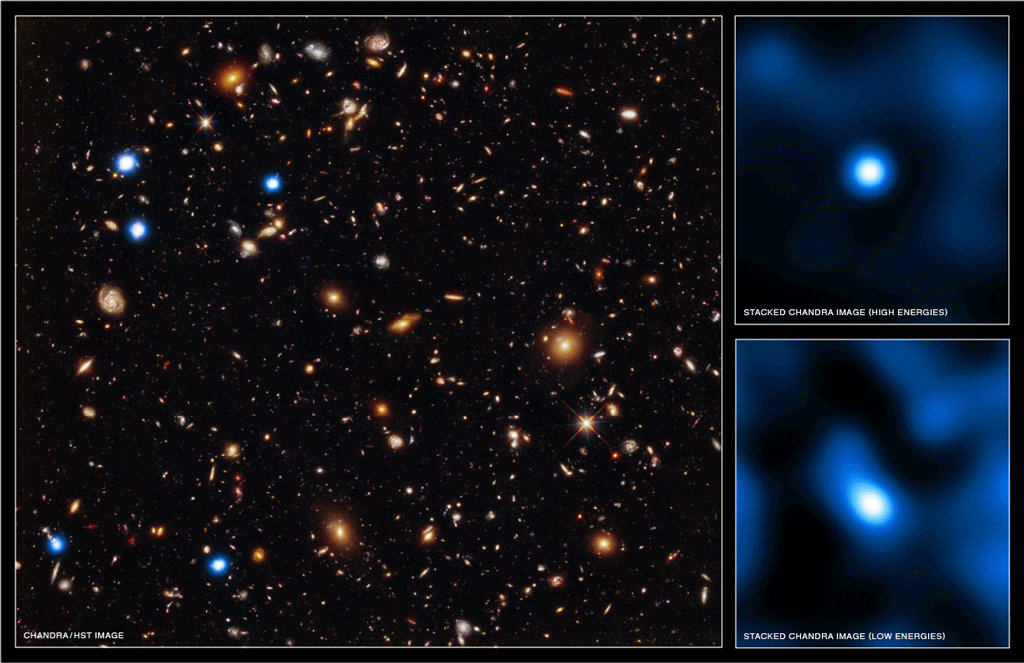Now a team of astronomers has discovered the earliest black holes ever detected, despite the fact that they are hidden from view by their host galaxies. They also measured the average growth rate of the black holes and discovered that they grow and evolve in tandem with their galaxies — something that astronomers had observed locally but that they knew little about when it came to the early, distant universe.
“This finding tells us there is a symbiotic relationship between black holes and their galaxies that has existed since the dawn of time,” said Kevin Schawinski, a Yale astronomer who contributed to the discovery.
The team used a technique called “stacking” in order to detect the incredibly weak signals emitted by the galaxies’ central black holes, the farthest of which are 13 billion light-years from Earth. Because of their great distance, astronomers see these black holes as they existed less than 1 billion years after the Big Bang. (The universe is currently estimated to be about 13.7 billion years old.)
The astronomers focused on more than 250 galaxies that had previously been detected by the Hubble Space Telescope that they thought were good candidates for harboring black holes at their centers. They then piled multiple images taken by the orbiting Chandra X-Ray Observatory on top of each other, essentially multiplying the weak X-ray signals created by the black holes as they devoured nearby gas and dust.
They detected only the most high-energy X-rays, Schawinski said, meaning the black holes must be hidden behind large quantities of dust and gas from their host galaxies. “This explains why they were so difficult to find,” he said.
Theorists, including Yale cosmologist Priyamvada Natarajan, used the observations to determine that even these earliest black holes appear to grow and evolve along with their host galaxies, which is similar to what astronomers have observed in the nearby universe.
“These observations indicate that extremely massive black holes already existed as early as 700 to 800 million years after the Big Bang, which suggests that either they were born massive to start with, or they experienced rapid growth bursts,” Natarajan said. “Either scenario tells us much more than we previously knew, which is very exciting.”
Next, the team hopes to use the Chandra observatory to look at an even bigger field of view so they can test theories about how these earliest black holes formed.
Now a team of astronomers has discovered the earliest black holes ever detected, despite the fact that they are hidden from view by their host galaxies. They also measured the average growth rate of the black holes and discovered that they grow and evolve in tandem with their galaxies — something that astronomers had observed locally but that they knew little about when it came to the early, distant universe.
“This finding tells us there is a symbiotic relationship between black holes and their galaxies that has existed since the dawn of time,” said Kevin Schawinski, a Yale astronomer who contributed to the discovery.
The team used a technique called “stacking” in order to detect the incredibly weak signals emitted by the galaxies’ central black holes, the farthest of which are 13 billion light-years from Earth. Because of their great distance, astronomers see these black holes as they existed less than 1 billion years after the Big Bang. (The universe is currently estimated to be about 13.7 billion years old.)
The astronomers focused on more than 250 galaxies that had previously been detected by the Hubble Space Telescope that they thought were good candidates for harboring black holes at their centers. They then piled multiple images taken by the orbiting Chandra X-Ray Observatory on top of each other, essentially multiplying the weak X-ray signals created by the black holes as they devoured nearby gas and dust.
They detected only the most high-energy X-rays, Schawinski said, meaning the black holes must be hidden behind large quantities of dust and gas from their host galaxies. “This explains why they were so difficult to find,” he said.
Theorists, including Yale cosmologist Priyamvada Natarajan, used the observations to determine that even these earliest black holes appear to grow and evolve along with their host galaxies, which is similar to what astronomers have observed in the nearby universe.
“These observations indicate that extremely massive black holes already existed as early as 700 to 800 million years after the Big Bang, which suggests that either they were born massive to start with, or they experienced rapid growth bursts,” Natarajan said. “Either scenario tells us much more than we previously knew, which is very exciting.”
Next, the team hopes to use the Chandra observatory to look at an even bigger field of view so they can test theories about how these earliest black holes formed.










